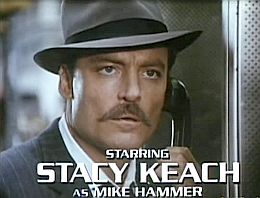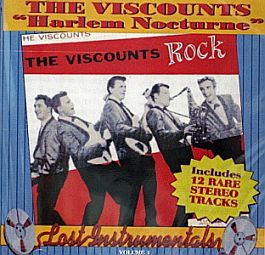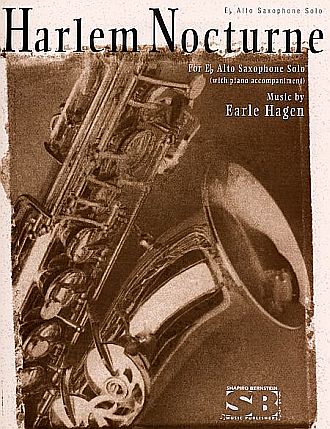
“Harlem Nocturne” sheet music cover from Shapiro Bernstein Music Publishers, Hal Leonard Corporation. Click for digital single.
Perhaps most notably the song came to wide popular notice in the early- and mid-1960s with a 1959 rendition, offered below, by a group called The Viscounts. But “Harlem Nocturne” would rise again in the 1980s, used for the TV series Mike Hammer and a related Hollywood film.
Music Player
“Harlem Nocturne” -1959-1966
In its musical sojourn, “Harlem Nocturne” became one of those classic and timeless instrumentals that filled the airways and nightclubs over the decades in many cover versions, even to this day. But the original “Harlem Nocturne” has its roots in late 1930s’ jazz and the big band era. Here’s some of that lineage.
Earle Hagen wrote and composed the song, along with Dick Richards. Hagen played trombone with Benny Goodman, Tommy Dorsey and the Ray Noble Orchestra, where he became an arranger in the late 1930s. On the road with the Noble Orchestra, Hagen composed “Harlem Nocturne,” and the song became a jazz standard.
Initially, Hagen wrote the song as a tribute to saxophonist Johnny Hodges, known for his solo work with Duke Ellington’s band. In writing the tune, Hagen had been inspired by Duke Ellington’s band. Johnny Hodges (1907-1970), meanwhile, became a legendary saxophonist
Hagen also intended the piece to be used by Jack Dumont, a saxophonist then with the Ray Noble Orchestra where Hagen worked. By 1941, “Harlem Nocturne” was also used as a theme song for the Randy Brooks Orchestra. In 1945, Johnny Otis recorded it as an early single on the Savoy label. In the early 1950s, saxophonist Herbie Fields released “Harlem Nocturne” as a single, then becoming one of the first popular jazz versions. And not long after that came a raft of cover versions by virtually every sax player in the R & B business. According to one source, there may be as many as 500 versions, making it one of the most covered songs in history. Among the many artists who have covered the song are: Duke Ellington, Harry James, the Glenn Miller Orchestra, the Lounge Lizards, Earl Bostic, Quncy Jones, Boots Randolph, guitarist Danny Gatton, the Ventures, and others.
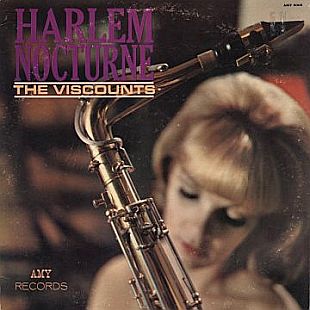
Cover art for 1965 LP version of “Harlem Nocturne” by The Viscounts, issued on the Amy record label. Click for album CD.
The Viscounts’ Hit
But it was the Viscounts, a New Jersey band, that put the song on the musical map in a new way in the late 1950s and early 1960s. The Viscounts were an instrumental quintet consisting of Harry Haller on tenor sax; Bobby Spievak, guitar; Joe Spievak, bass; Larry Vecchio on organ; and Clark Smith on drums.
In addition to Harry Haller’s excellent work on the sax, The Viscounts’ 1958 recording of the song added a new twist — an eerie guitar echo effect that’s been retained in many subsequent versions.
The Viscounts’ version was first released in 1959 on the Madison record label — a New York city label started in 1958. In January 1959, “Harlem Nocturne” began climbing the pop charts and would peak at No.52.
Although the Viscounts’ 1959 version of “Harlem Nocturne” did not crack the Top 40, it remained one of the most recognizable instrumentals of that era. The group then followed up with two other instrumentals on the Madison label — “Night Train” and “Wabash Blues.” Then six or so years passed. In 1965-66, the Viscounts’ version of “Harlem Nocturne” got a second chance; it was reissued on another record label, Amy. This time, in January of 1966, the song rose to No. 39, cracking the Top 40 for a brief one week stay. Music critic Dave Marsh includes the Viscounts’ version of “Harlem Nocturne” in his 1999 book, The Heart of Rock & Soul: the 1001 Greatest Singles Ever Made.
T.V. Music
Earle Hagen, meanwhile, who had written “Harlem Nocturne” in the late 1930s, became quite successful in songwriting for television. He began writing music for TV shows in 1952 with partner Herbert W. Spencer. In 1953 while Hagen was writing the music for the Danny Thomas show Make Room for Daddy, he met TV producer Sheldon Leonard.
Leonard liked the idea of using original soundtracks for his shows rather than canned studio music, and soon made use of Hagen’s talents to produce music for a number of 1960s’ TV shows including: The Andy Griffith Show (1960-68), The Dick Van Dyke Show (1961-66), I Spy (1965-68), and The Mod Squad (1968-1973). But in the 1980s, Hagen returned to his 1930s tune, “Harlem Nocturne,” using it as the signature theme for the television series Mickey Spillane’s Mike Hammer in 1984, and also for the 1986 film, The Return of Mike Hammer. The version of “Harlem Nocturne” used for the Mike Hammer shows, however, was not the Viscounts’ version.
Hagen would later write books on music scoring, including, Scoring for Films: A Complete Text. His autobiography, Memoirs of a Famous Composer Nobody Ever Heard Of, was published in 2000. Hagen died of natural causes in May 2008. He was 89.As for the Viscounts’s history after “Nocturne,” in addition to their other songs already mentioned, they also recorded and released other work, including: jazzy versions of “Summertime,” “September Song,” and “Sophisticated Lady.” More hard rocking versions of their tunes include: “Rock,” “Dig,” “Night Train,” and others. One CD of their music, containing 30 of their songs, is reviewed song-by-song at Reverb Central.com. The review of the “Harlem Nocturne” track notes, for example: “It features the very intense and sultry sax of Harry Haller, which drives this track with the danger of a back alley. The throbbing vibrato guitar adds to the ominous sound. This is one magnificent track.”
Other music stories at this website can be found at the “Annals of Music” category page, or the “1950s Pop Music” page. Thanks for visiting — and if you like what you find here, please make a donation to help support the research and writing at this website. Thank you. — Jack Doyle
|
Please Support Thank You |
_________________________________
Date Posted: 27 June 2010
Last Update: 4 June 2023
Comments to: jdoyle@pophistorydig.com
Article Citation:
Jack Doyle, “Harlem Nocturne, 1939-1980s,”
PopHistoryDig.com, June 27, 2010.
_________________________________
Sources, Links & Additional Information
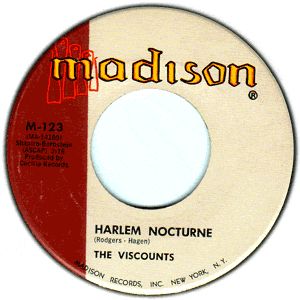
The Viscounts’ first version of “Harlem Nocturne” on the Madison record label, 1959-1960.
“Earle Hagen,” Wikipedia.org.
Clinton McClung, “42 Versions of Harlem Nocturne,” Blog.WFMU.org, May 29, 2008. Site includes various cover versions of “Harlem Nocturne” with built-in music players.
“The Man Behind The Theme,” AM, Then FM, May 28, 2008.
Joel Whitburn, The Billboard Book of Top 40 Hits, 8th edition, New York: Billboard Books, 2004, p. 662.
Dave Marsh, The Heart of Rock & Soul: The 1001 Greatest Singles Ever Made, New York: Da Capo Press, 1999, p. 610.
“Harlem Nocturne,” Wikipedia.org.
_______________________

Photo of The Viscounts, circa 1950-1960s, from reverse side of one of their albums. Members include (not necessarily in order as shown): Larry Vecchio on organ; Bobby Spievak, guitar; Joe Spievak, bass; Harry Haller on tenor sax; and Clark Smith on drums.
